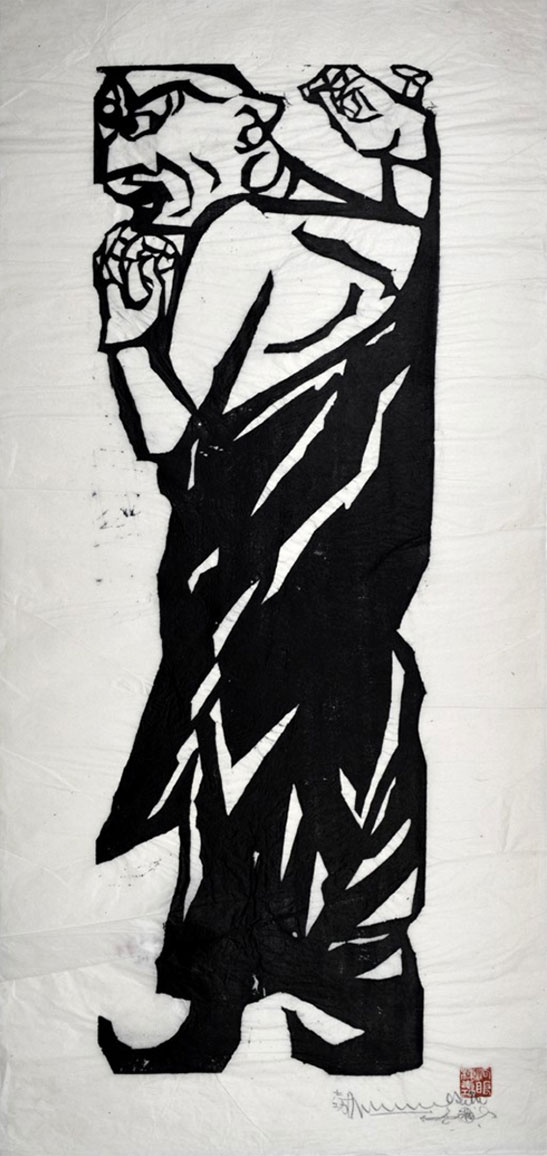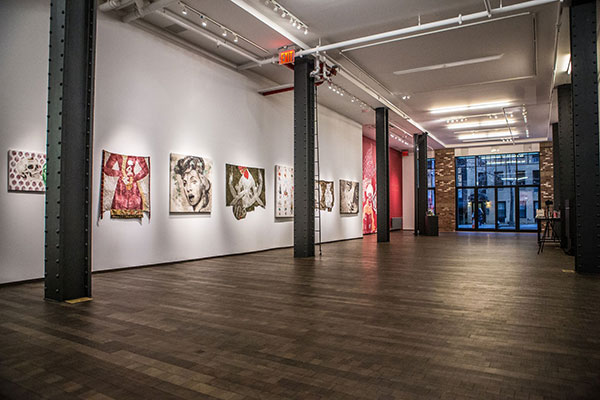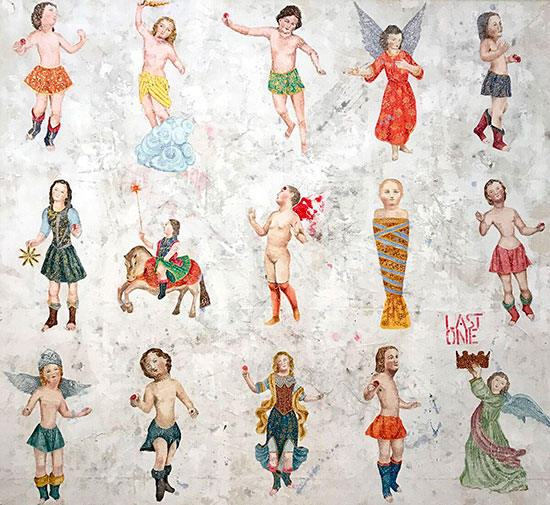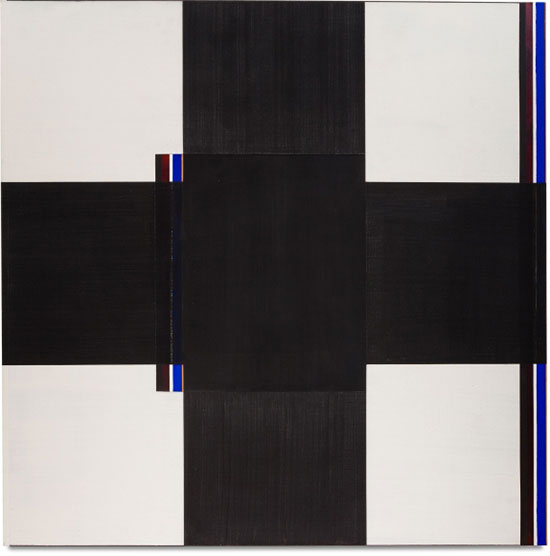This week’s selection features three rewarding shows just steps from Fifth Avenue on the stretch from 22nd to 73rd street: A master class in printmaking from Shiko Munakata is on view at the Ronin Gallery at 49th and Madison. Michela Martello’s “Future is Goddess” show is in line with the feminist cause espoused at the fantastic Flatiron space occupied by Pen + Brush on 22nd Street. And a rare glimpse of the abstraction of Harvey Quaytman can be had at Van Doren Waxter on 73rd.
Munakata at Ronin Gallery
The Ronin Gallery declares that Shiko Munakata (1903-1975) was “Japan's greatest modern print artist.” The assertion is borne out by the boldly expressionist lines and often comical vitality of the major works on view in the meticulously presented show, “Munakata and the Disciples of Buddhism.”
Following the tradition of the ukiyo-e genre of woodblock prints and paintings, there are two major print movements in modern Japan. Munakata—like Picasso or Miro threading the passage between the Surrealists and School of Paris—maintained his independence while taking what he needed from the Sosaku Hanga (creative print) and Mingei (folk art) movements. To this he added a measure of earthy Buddhism and the figural athleticism of Paul Gauguin (a childhood idol) or Max Beckmann.
In a medium classified by the relationship between the physical mark made by the cutting instrument and the style of the print, the tools are the rules, and a vitrine displays Munakata’s surprisingly modest chisels and knives. He preferred the children’s versions, blasting through sets of them as he cut with rapid vigor.
The highlight of the show is a series of 10 disciples of Buddha, large (nearly four feet high) vertical compositions printed in 1960 with the figures crammed to the very edge of the block. My favorite was the passionate Pūrnamaitrāyanīputra, Master of Teaching with its balled fists, crossed eyes and gaping mouth. This figure seems to anticipate the modern teacher’s battle for attention in the era of students hypnotized by their smartphones.
.

"Pūrnamaitrāyanīputra, Master of Teaching" by Shiko Munakata, 1960. Woodblock print, 41.75 x 18.75 inches. Courtesy of Ronin Gallery.
.
Munakata had a gift for touching up black and white images with color, like the Renoir-worthy undercurve of the breast in two swift pink strokes added to a cheerful portrait of the goddess Guanyin.
“Munakata and the Disciples of Buddhism” is on view March 7 through April 29, 2017 at Ronin Gallery, 3rd Floor, 425 Madison Avenue (SE Corner of 49th St.), New York, NY 10017. www.roningallery.com.
Michela Martello at Pen + Brush
In “Future is Goddess,” Michela Martello exploits her fluent draftsmanship to transport the theme of goddesses from pensive classical Greek and Roman sources to the curvaceous idols of southeast Asia.
The artist had a fight on her hands in her native Italy just trying to enroll in the Accademia Di Belle Arti di Brera in Milan at a time when political unrest bordering on anarchy left her standing outside shouting at the windows to be admitted. She chose instead to become a professional illustrator, and the narrative clarity of her painting—including a stunning mural that captures glances on 22nd Street—stems from the decade she spent in that trade. Banging out the imagery on deadline builds the chops.
.

“Future is Goddess" by Michela Martello at Pen + Brush. Photo: Manny Fernandes.
.
Martello ambitiously tackles the iconography of art history, in one piece riffing on Botticelli. And in one particularly splendid painting made on an old studio dropcloth that had been roughed up Arte Povera style, she floats the gentle face of Psyche rendered on a large scale after glimpsing a small terra cotta figurine at the Metropolitan Museum. The chalky whites and faraway gaze remind me of Picasso’s Woman in White, completed shortly after he had visited the Farnese marbles with Diaghilev and Cocteau.
.

"Psyche" by Michela Martello, 2010. Mixed media on canvas. Courtesy of Pen + Brush.
.
Martello’s Buddhist side emerges in the whimsical 15 Manifestations of Happiness, with its winking “shave and a haircut” finale stenciled in the lower right hand corner: “Last One.”
Michela Martello solo exhibition, “Future is Goddess,” is on view March 4 through April 22, 2017 at Pen + Brush, 29 East 22nd Street, New York, NY 10010. www.penandbrush.org
.

"15 Manifestation of Happiness" by Michela Martello, 2009. Acrylic and gesso on cotton. Courtesy of Pen + Brush.
.
“Harvey Quaytman: Hone” at Van Doren Waxter
Even into the ’90s, Harvey Quaytman (1937-2002) was hewing to the geometric course he established in art school in the ’50s. Born in 1937 in Far Rockaway, he was the son of an accountant and a piano teacher. After Syracuse University, he earned degrees at Tufts and the School of the Museum of Fine Arts in Boston, where he met his first wife the poet Susan Howe. Their daughter Rebecca is also an artist.
Quaytman was part of a solid generation of abstract painters who took their cue not just from the Suprematists and the neo-plasticism of Mondrian but also from the color theories of Albers and Matisse, correlating volume and effect. In his work, Quaytman was an inventive dramatist with his palette who brought a sculptor’s flair for form to the game of the shaped canvas.
The extension of a black band of textured tape (crushed glass added grit) across the edge where the painting ends and the wall begins shows a disdain for boundaries comparable to Frank Stella’s treatment of the shaped canvas. Edges are not always as hard as they appear in reproduction—little variations in texture have a humanizing effect. And the cruciform composition is one of the most important elements in the essential Quaytman.
.

"Harvey Quaytman: Hone" at Van Doren Waxter. Courtesy of the gallery.
.
The star turn in the show is Hone (1988), an imposing homage to the Mondrian diamond in blue and black with a surprisingly tender fragility to its taped lines. My own favorite, for its range of vermilion and deeper blues woven with the black, is Jacob’s Coat (1984), a work that offered an even greater sensuality than its predecessors.
.

"Jacob's Coat" by Harvey Quaytman, 1984. Acrylic on canvas, 80 x 80 inches. Van Doren Waxter.
.
In the catalogue, Quaytman has this to say about color: “I have no specific meanings, but a color must mean something to me before I use it. I must love that color and it must strike me.”
“Harvey Quaytman: Hone” is on view February 22 to April 28, 2017 at Van Doren Waxter Gallery, 22 East 73rd Street, New York, NY 10021. www.vandorenwaxtergallery.com
__________________________________
Copyright 2017 Hamptons Art Hub LLC. All rights reserved.

there’s a certain similarity between martello’s use of the dropcloth and marisa merz now on view at met breuer